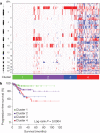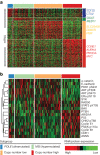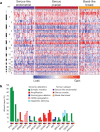Integrated genomic characterization of endometrial carcinoma
- PMID: 23636398
- PMCID: PMC3704730
- DOI: 10.1038/nature12113
Integrated genomic characterization of endometrial carcinoma
Erratum in
- Nature. 2013 Aug 8;500(7461):242
Abstract
We performed an integrated genomic, transcriptomic and proteomic characterization of 373 endometrial carcinomas using array- and sequencing-based technologies. Uterine serous tumours and ∼25% of high-grade endometrioid tumours had extensive copy number alterations, few DNA methylation changes, low oestrogen receptor/progesterone receptor levels, and frequent TP53 mutations. Most endometrioid tumours had few copy number alterations or TP53 mutations, but frequent mutations in PTEN, CTNNB1, PIK3CA, ARID1A and KRAS and novel mutations in the SWI/SNF chromatin remodelling complex gene ARID5B. A subset of endometrioid tumours that we identified had a markedly increased transversion mutation frequency and newly identified hotspot mutations in POLE. Our results classified endometrial cancers into four categories: POLE ultramutated, microsatellite instability hypermutated, copy-number low, and copy-number high. Uterine serous carcinomas share genomic features with ovarian serous and basal-like breast carcinomas. We demonstrated that the genomic features of endometrial carcinomas permit a reclassification that may affect post-surgical adjuvant treatment for women with aggressive tumours.
Conflict of interest statement
The author declares no competing financial interests.
Figures





Comment in
-
Genetics: new classification for endometrial cancer puts genes in POLE position.Nat Rev Clin Oncol. 2013 Jun;10(6):304. doi: 10.1038/nrclinonc.2013.82. Epub 2013 May 14. Nat Rev Clin Oncol. 2013. PMID: 23670659 No abstract available.
Similar articles
-
Utility of a custom designed next generation DNA sequencing gene panel to molecularly classify endometrial cancers according to The Cancer Genome Atlas subgroups.BMC Med Genomics. 2020 Nov 30;13(1):179. doi: 10.1186/s12920-020-00824-8. BMC Med Genomics. 2020. PMID: 33256706 Free PMC article.
-
Molecular Genetics of Endometrial Carcinoma.Annu Rev Pathol. 2019 Jan 24;14:339-367. doi: 10.1146/annurev-pathol-020117-043609. Epub 2018 Oct 17. Annu Rev Pathol. 2019. PMID: 30332563 Review.
-
Clinicopathological analysis of endometrial carcinomas harboring somatic POLE exonuclease domain mutations.Mod Pathol. 2015 Apr;28(4):505-14. doi: 10.1038/modpathol.2014.143. Epub 2014 Nov 14. Mod Pathol. 2015. PMID: 25394778
-
High frequency of POLE mutations in synchronous endometrial and ovarian carcinoma.Hum Pathol. 2019 Mar;85:92-100. doi: 10.1016/j.humpath.2018.11.001. Epub 2018 Nov 15. Hum Pathol. 2019. PMID: 30448219
-
The emerging genomic landscape of endometrial cancer.Clin Chem. 2014 Jan;60(1):98-110. doi: 10.1373/clinchem.2013.205740. Epub 2013 Oct 29. Clin Chem. 2014. PMID: 24170611 Free PMC article. Review.
Cited by
-
Molecular classification and adjuvant treatment in endometrioid endometrial cancer with microcystic elongated and fragmented (MELF) invasion pattern.BMC Womens Health. 2024 Nov 15;24(1):607. doi: 10.1186/s12905-024-03449-6. BMC Womens Health. 2024. PMID: 39548429 Free PMC article.
-
Genetic variation perspective reveals potential drug targets for subtypes of endometrial cancer.Sci Rep. 2024 Nov 15;14(1):28180. doi: 10.1038/s41598-024-78689-5. Sci Rep. 2024. PMID: 39548148 Free PMC article.
-
Genomic instability as a driver and suppressor of anti-tumor immunity.Front Immunol. 2024 Oct 11;15:1462496. doi: 10.3389/fimmu.2024.1462496. eCollection 2024. Front Immunol. 2024. PMID: 39544936 Free PMC article. Review.
-
SOX17 expression in ovarian clear cell carcinoma.J Ovarian Res. 2024 Nov 11;17(1):221. doi: 10.1186/s13048-024-01549-3. J Ovarian Res. 2024. PMID: 39529086 Free PMC article.
-
Treatment Strategies for Advanced Endometrial Cancer According to Molecular Classification.Int J Mol Sci. 2024 Oct 24;25(21):11448. doi: 10.3390/ijms252111448. Int J Mol Sci. 2024. PMID: 39519001 Free PMC article. Review.
References
-
- Lax SF, Kurman RJ. A dualistic model for endometrial carcinogenesis based on immunohistochemical and molecular genetic analyses. Verh. Dtsch. Ges. Pathol. 1997;81:228–232. - PubMed
-
- Cheung LW, et al. High frequency of PIK3R1 and PIK3R2 mutations in endometrial cancer elucidates a novel mechanism for regulation of PTEN protein stability. Cancer Discov. 2011;1:170–185. doi: 10.1158/2159-8290.CD-11-0039. - DOI - PMC - PubMed
Publication types
MeSH terms
Substances
Grants and funding
- 5U24CA143835-04/CA/NCI NIH HHS/United States
- 5U24CA143845-04/CA/NCI NIH HHS/United States
- P30 CA016086/CA/NCI NIH HHS/United States
- 5U24CA143867-04/CA/NCI NIH HHS/United States
- U24 CA143840/CA/NCI NIH HHS/United States
- U24 CA143848/CA/NCI NIH HHS/United States
- U54 HG003079/HG/NHGRI NIH HHS/United States
- U24 CA143867/CA/NCI NIH HHS/United States
- 5U24CA144025-04/CA/NCI NIH HHS/United States
- 5U24CA143840-04/CA/NCI NIH HHS/United States
- 5U24CA143848-04/CA/NCI NIH HHS/United States
- P30 CA016672/CA/NCI NIH HHS/United States
- U24 CA143882/CA/NCI NIH HHS/United States
- U54HG003067-11/HG/NHGRI NIH HHS/United States
- U54 HG003067/HG/NHGRI NIH HHS/United States
- P30 CA016056/CA/NCI NIH HHS/United States
- U24 CA143835/CA/NCI NIH HHS/United States
- 5U24CA143882-04/CA/NCI NIH HHS/United States
- U24 CA143866/CA/NCI NIH HHS/United States
- 5U24CA143866-04/CA/NCI NIH HHS/United States
- U24 CA143845/CA/NCI NIH HHS/United States
- U24 CA143799/CA/NCI NIH HHS/United States
- P50 CA098258/CA/NCI NIH HHS/United States
- U54HG003079-10/HG/NHGRI NIH HHS/United States
- U54 HG003273/HG/NHGRI NIH HHS/United States
- P30 CA008748/CA/NCI NIH HHS/United States
- U24 CA144025/CA/NCI NIH HHS/United States
- U54HG003273-10/HG/NHGRI NIH HHS/United States
- U24 CA143843/CA/NCI NIH HHS/United States
- 5U24CA143799-04/CA/NCI NIH HHS/United States
- R01 CA180006/CA/NCI NIH HHS/United States
- 5U24CA143843-04/CA/NCI NIH HHS/United States
- U24 CA143858/CA/NCI NIH HHS/United States
- 5U24CA143858-04/CA/NCI NIH HHS/United States
- 5U24CA143883-04/CA/NCI NIH HHS/United States
- U24 CA143883/CA/NCI NIH HHS/United States
LinkOut - more resources
Full Text Sources
Other Literature Sources
Research Materials
Miscellaneous


